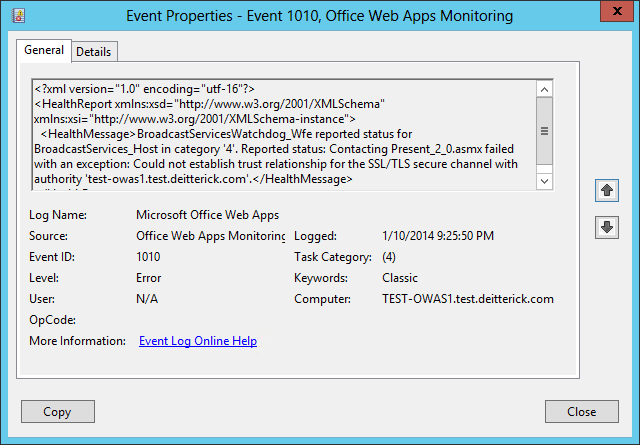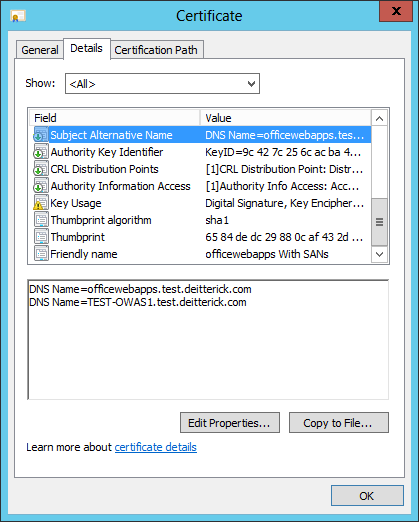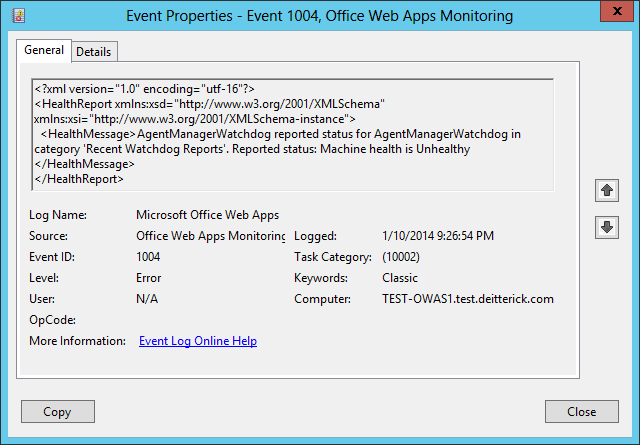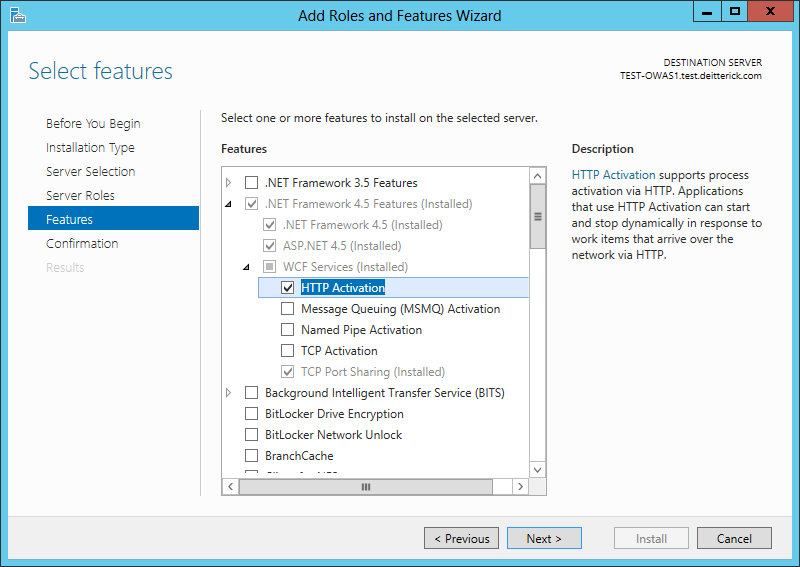How to Get Office Web Apps Server 2013 to Report a Healthy Health Status
I see this a lot in customer environments with Office Web Apps Server 2013 deployed for use with Lync Server 2013, where if you run the Get-OfficeWebAppsMachine cmdlet, the HealthStatus parameter is Unhealthy:
However, even though Office Web Apps Server 2013 reports as unhealthy, as far as Lync Server 2013 is concerned, everything is working fine. Presenters in meetings are able to upload PowerPoint presentations and attendees can see the presentations. So what is causing the unhealthy status and how do you fix it?
There are generally two issues that could be causing Office Web Apps Server 2013 to report as unhealthy. If you look in the Microsoft Office Web Apps Event Log on the Office Web Apps Server 2013 server, you may see an error similar to the following:
<?xml version="1.0" encoding="utf-16"?>
<HealthReport xmlns:xsd="https://www.w3.org/2001/XMLSchema" xmlns:xsi="https://www.w3.org/2001/XMLSchema-instance">
<HealthMessage>BroadcastServicesWatchdog_Wfe reported status for BroadcastServices_Host in category '4'. Reported status: Contacting Present_2_0.asmx failed with an exception: Could not establish trust relationship for the SSL/TLS secure channel with authority 'test-owas1.test.deitterick.com'.</HealthMessage>
</HealthReport>
In this error message, you can see that there appears to be an issue with the certificate being used for the Office Web Apps Farm:
Could not establish trust relationship for the SSL/TLS secure channel with authority 'test-owas1.test.deitterick.com'.
This is because when you create the certificate for the Office Web Apps Farm, you need to include SAN entries for all servers in the farm. Even if there's only a single server in the farm, if the names that you enter for the ExternalURL and/or InternalURL parameters are different than the server FQDN, you will need to add the server FQDN to the certificate. In this example, I have a single Office Web Apps Server 2013 server and for the ExternalURL and InternalURL parameters, I've entered:
When creating the certificate for the Office Web Apps Farm, I needed to add the server FQDN as a SAN entry to the certificate:
This may be enough to resolve your issue and get Office Web Apps Server 2013 to report healthy:
Note: It may take awhile for the server to report a HealthStatus of Healthy.
If you are still seeing the HealthStatus reported as Unhealthy:

There may still be an additional error showing up in the Microsoft Office Web Apps Event Log:
<?xml version="1.0" encoding="utf-16"?> <HealthReport xmlns:xsd="https://www.w3.org/2001/XMLSchema" xmlns:xsi="https://www.w3.org/2001/XMLSchema-instance"> <HealthMessage>AgentManagerWatchdog reported status for AgentManagerWatchdog in category 'Recent Watchdog Reports'. Reported status: Machine health is Unhealthy</HealthMessage> </HealthReport>
This error is generally caused by not having the HTTP Activation feature installed on the Office Web Apps Server 2013 server:
You can install the missing feature using Server Manager or by running the following PowerShell cmdlet:
Add-WindowsFeature NET-WCF-HTTP-Activation45
After adding the missing feature, the Office Web Apps Server 2013 should now report healthy:
Note: It may take awhile for the server to report a HealthStatus of Healthy.
Comments
- Anonymous
January 01, 2003
is it possible that in a Office Web Apps Server which status is "Unhealthy" only ppt and pptx documents cannot be previsualized? The rest of the documents works without problem- Anonymous
June 05, 2017
Hi!I have the same situation as you albandrod: Unhealthy status, pptx cannot be viewed other documnets working.Could this be related to security patching?Input from anyone greatly appreciated
- Anonymous
- Anonymous
January 01, 2003
The comment has been removed - Anonymous
January 01, 2003
@John Lemoine As Bjorn mentions, the .NET 4.5 install on Windows Server 2008 R2 installs everything that's needed. - Anonymous
January 01, 2003
Thanks for sharing - Anonymous
January 01, 2003
@Codamnet
Make sure that you're certificate has the new FQDN and you may need to remove and recreate the farm. I've never tried to change the full computer name of a machine that's been joined to AD, so that might be causing you some issues as well. - Anonymous
January 01, 2003
@Alan Coulter
If your server FQDNs are using a non-public TLD, then you are correct that getting a certificate from a public CA is going to be an issue. You can consider using a certificate from on internal CA if you have one available. - Anonymous
January 16, 2014
Thank you for this article. - Anonymous
January 23, 2014
Great article and I never realised that you need the server names on the certificate before. Is that documented on TechNet and I've missed it? This brings about a question though as most SSL certificate providers now will not let you purchase a certificate with an internal name on now so this might cause a problem for a few people. - Anonymous
January 23, 2014
To echo Andy's comment after 2015 cert authorities will not put local names on certificates and they are starting to make it harder now. - Anonymous
January 29, 2014
How do you enable .Net 4.5 HTTP Activation in WCF on a Windows 2008 R2 server, the server admin interface is not the same as on Windows 2012 servers. I have not been able to find much documentation on managing these features on the older platforms. - Anonymous
February 02, 2014
@John: You need to enable the http activation under .net 3.5 and reinstall/repair your .net 4.5 installation. The installation for .net 4.5 automaticly activates the features you've activated under .net 3.5 on a 2008R2 machine. (This also fixes an issues with Lync 2013 - 2010 clients sharing a powerpoint.) - Anonymous
February 28, 2014
Hi,
I changed the suffix of my computer from contosco.local to contosco.com but I still receive error that my Office Web server can not reach the Https://officeserver.contosco.local/. I can ping my server with new suffix and I'm also able to see that it was changed the FQDN on my Active directory server. I'm able to open documents using Office web apps but I getting a lot of log error. Is there a way that I can change it?
Thanks!
This is the error that I'm receiving:
<?xml version="1.0" encoding="utf-16"?>
<HealthReport xmlns:xsd="http://www.w3.org/2001/XMLSchema" xmlns:xsi=";
<HealthMessage>BroadcastServicesWatchdog_Wfe reported status for BroadcastServices_Host in category '4'. Reported status: Contacting Present_2_0.asmx failed with an exception: An error occurred while making the HTTP request tohttps://officewebserver.contosco.local/m/Present_2_0.asmx. This could be due to the fact that the server certificate is not configured properly with HTTP.SYS in the HTTPS case. This could also be caused by a mismatch of the security binding between the client and the server.</HealthMessage>
</HealthReport> - Anonymous
March 19, 2014
The comment has been removed - Anonymous
April 07, 2014
Update 1/12/13 - Updated with additional information. Update 11/10/13 - Updated with links to updates - Anonymous
April 23, 2014
I'd like to add that if you install OWAS outside of C:, it will also report as unhealthy. This is not in any OWAS documentation, but has been confirmed by our MS Acct Rep. - Anonymous
September 24, 2014
The comment has been removed - Anonymous
November 22, 2014
Thanx, very helpful! in my case it will be a HTTP Activation...Used this articlehttp://technet.microsoft.com/en-us/library/jj219455(v=office.15).aspx - Anonymous
January 16, 2015
Thank you for sharing it helps me a lot !! - Anonymous
April 19, 2015
With the issue relating to the server FQDN needing to be added to the certificate for officewebapps.contoso.com via the Subject Alternative Name list, it appears that you can no longer do this for public certificates. In my case I could see that even though I registered the OWA farm to use (say) officewebapps.contoso.com, under the covers the event log was reporting an error and was trying to connect to owaserver.contoso.local. As I was using Windows 2012 R2 I updated the IIS bindings to have a host header for officewebapps.contoso.com. This seems to get rid of the error, but the health status is still reported as unhealthy (and every other alternative in the article has been verified). Any suggestions? - Anonymous
November 18, 2015
So SAN FQDN is required for my internal CA cert even if it is a single server farm? What about the use of a internal CA wildcard cert? - Anonymous
November 19, 2015
@toneman
Yes, if the farm FQDN and the server FQDN are different. I'm not sure what the support position is on wildcard certs with Office Web Apps Server 2013. - Anonymous
May 24, 2016
DOUG TO THE RESCUE!! - Anonymous
September 27, 2016
The comment has been removed - Anonymous
March 02, 2017
I got the second Error and I added the second feature, but the Farm is till unhealthy!! I can open Excel files using Office Web Apps but I am not able to open PPT files and I got an error saying "Sorry we ran into o problem". I am struggling with that issue and tries so many solutions but it is not working! We are using http protocol and we generated the certificate using IIS internally. Any idea please ?





